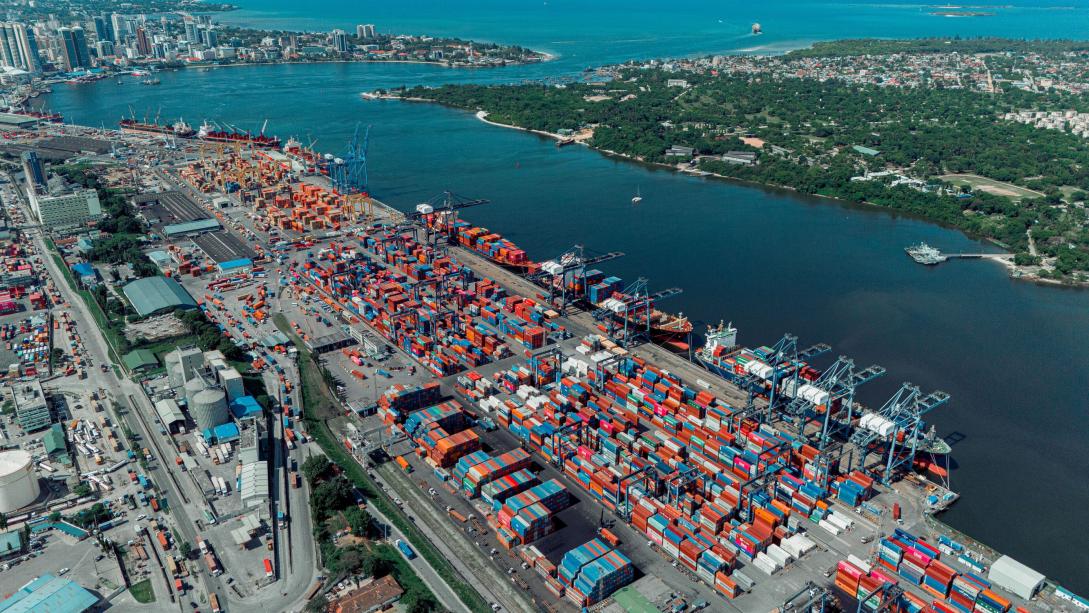Will the EU’s Global Gateway Strategy Shape Dar es Salaam Port?

A European Union (EU) delegation led by Hans Stausboll, Acting Director for Africa at the European Commission, arrived at the sprawling expanse of the Port of Dar es Salaam. The hum of operations set the tone for the visit as they were driven through the port’s vibrant grounds in a Toyota Coaster.
A towering banner welcomed the group, boldly inscribed with Swahili words: “Lango la Biashara Kitaifa na Kimataifa”—a gateway to business nationally and internationally.
Beneath the slogan lay a hive of activity: containers stacked like lego bricks, cranes suspended mid-air, and vehicles neatly aligned at the roll-on, roll-off (RoRo) terminal ramp, ready to be dispatched to their owners.
For shopkeepers like Amina in Dar es Salaam’s busy Kariakoo market, however, the port’s promise hasn’t always materialized. “Bado mzigo wangu haujatoka bandarini” (“My goods are still stuck at the port”), she often explains to customers frustrated by delays and rising prices.
Yet, this isn’t the full story.
The port, which handles 95% of Tanzania’s international trade, has made impressive strides in recent months. According to the Tanzanian government, vessel waiting times have been slashed by 85%, dropping from an average of 46 days in May to just seven days by September 2024. Container throughput has surged, reaching record levels of 27,000 Twenty-Foot Equivalent Units (TEUs) per month—far exceeding the previous peak of 15,000 TEUs.
However, challenges remain. Operational bottlenecks, customs delays, and inefficiencies still hinder businesses, particularly those dependent on quick turnarounds.
This is where the European Union-funded Tanzania Trade and Transport Improvement Project comes in. Launching in early 2025 with a budget of TZS 41.91 billion (EUR 15 million), the initiative will address these persistent challenges.
A collaboration between Enabel, UN-Habitat, TradeMark Africa, and the Port of Antwerp-Bruges International, the project builds on the Tanzania Ports Authority’s (TPA) ongoing efforts to modernize and streamline operations.
“We are working to ensure this gateway fully lives up to its name by facilitating trade that drives growth both nationally and internationally,” says Mr. Stausboll.
He emphasizes the project’s alignment with the EU’s Global Gateway strategy, which focuses on fostering sustainable growth, improving trade infrastructure, and supporting value addition in Tanzania’s exports.
The project will not only optimize port operations but also promote trade facilitation measures, reduce non-tariff barriers, and improve customs procedures. Reflecting Tanzania’s aspirations for a low-carbon economy, it will introduce electric mobility solutions to create greener and more efficient logistics.
“The Port of Dar es Salaam is the heartbeat of Tanzania’s economy,” says Plasduce Mbossa, Director General of the Tanzania Ports Authority. “Thanks to ongoing reforms and strategic partnerships, we’ve significantly enhanced our operational capacity and reduced delays, making the port a reliable gateway for regional trade.”
As an anchor port supporting not just Tanzania’s trade but also that of its landlocked neighbors—Rwanda, Burundi, and the Democratic Republic of Congo—Dar es Salaam plays a pivotal role in facilitating regional integration. Its efficiency and effectiveness are key to unlocking the flow of trade and boosting competitiveness across East Africa.
With projects like the Tanzania Trade and Transport Improvement Project complementing recent achievements, the Port of Dar es Salaam is poised to solidify its position as a vital gateway for trade and economic growth—both locally and globally.





